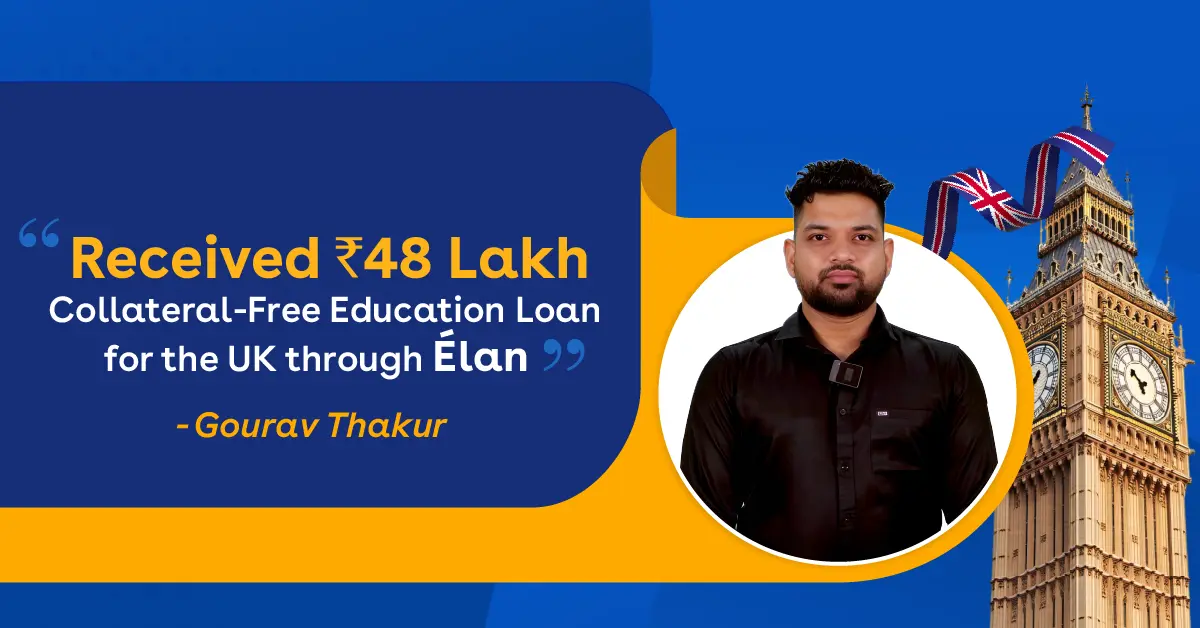Jun 23, 2025
Education Loan for MS in Australia: Lenders, Expenses Covered, Eligibility, Process & More
Australia, the world’s largest island nation, continues to be one of the most sought-after destinations for international education. According to the QS World University Rankings 2025, Australia is home to 9 of the World’s Top 100 Universities — a reflection of its global academic reputation.
With MD 111 now replacing MD 107, and the Australian student visa system prioritizing applications for high-demand sectors, the pathway for international students has become more streamlined. This is especially relevant for those pursuing fields such as Engineering, Information Technology, or Business. Programs like the Master of Science remain highly popular due to their academic depth, diverse career outcomes, and international recognition.
That said, while the aspiration to study in Australia is widespread, financing such an education remains a challenge for many. Without the support of financial aid, turning this dream into reality wouldn’t be feasible for many Indian students. This is where an Australia student loan becomes essential.
Before we explore the key elements, first take a brief look at why choosing to pursue an MS in Australia could be a wise decision.
Why Study MS in Australia?
There are numerous popular study destinations to choose from; so why should Australia be your preferred choice for pursuing a Master of Science Degree? These are the reasons.
Graduate with a Globally Trusted Degree in Science: Australian Universities like the University of Queensland and Monash offer MS Degrees that are Globally Ranked and professionally accredited, making your qualification instantly recognized by employers and institutions worldwide.
Strategic Alignment with Australia’s Priority Occupations: Australia’s Skilled Occupation List prioritizes fields like Data Science, Environmental Sciences, and Biotechnology, which are core focus areas of MS programs.
Access to Competitive Scholarships and Funded Research Projects: Several Universities support MS students through Financial Aid, Assistantships, or Research Funding.
Industry-Focused Curriculum Designed for Employability: Most Australian Universities embed Practical Training, Research Projects, and Industry Collaboration into their MS Programs.
Now that you have compelling reasons to choose Australia, we now explore the costs associated with pursuing Master of Science Program here.
Cost to Study MS in Australia
To apply for an education loan for, it is important to understand the overall cost of the study. Apart from the tuition fees, one of the major additional expenses is the cost of living in Australia, both of which are outlined below.
|
|
|
|
|
|
|
|
|
Note: Please remember that cost of living may vary according to the accommodation type and lifestyle preferences.
The overall cost of pursuing an MS in Australia may seem overwhelming at first. However, with the support of a study abroad loan, financing your education becomes more manageable.
What loan options are available if you choose this route? It’s time to find out.
Types of Financial Lenders for MS in Australia
When you decide to apply for an Overseas Education Loan, you typically have two options: Secured Loans and Unsecured Loans.
Secured Loans require you to provide a Collateral, such as property or fixed assets, as security against the loan amount. On the other hand, Unsecured Loans do not require any form of collateral as security.
Both options come with their own advantages and limitations, and a wide range of Financial Lenders in India offer these loans—some specializing specifically in either Secured or Unsecured Loans.
For Australia, students should confirm with the university after receiving their offer whether a secured or unsecured loan is accepted. Most universities prefer secured loans, as they make the applicant's profile appear more genuine.
In the following sections, we will help you understand each type of Financial Lender in detail, one at a time.
Nationalized Banks
Nationalized Banks in India are Government-Owned Banks that operate under the supervision of the Reserve Bank of India (RBI). These banks were previously private but were brought under government control to improve access to formal banking services, including Education Loans for higher studies.
They are known for Regulated Interest Rates, Longer Repayment Terms, and well-structured Grievance Redressal Mechanisms. Though documentation is strict, their credibility and trust make them a preferred choice for many students.
Top Nationalized Banks Offering Education Loan for MS in Australia
State Bank of India (SBI)
Secured Loan: Up to 3 Crore
Unsecured Loan: Up to 50 Lakhs (Only for SBI-Selected Premier Institutions)
Bank of Baroda
Premier Institutions (Secured): Up to 1.5 Crore
Non-Premier Institutions (Secured): Up to 60 Lakhs
Bank of India
Secured Loan: Up to 1.5 Crore
Union Bank of India
Secured Loan: Up to 1.5 Crore
Unsecured Loan:
1. Top 160 Universities (Prime A): Up to 40 Lakhs
2. Top 100 Universities (Prime B): Up to 30 Lakhs
Punjab National Bank (PNB)
Secured Loan: Up to 1.5 Crore
Bank of Maharashtra
Secured Loan: Up to 1.5 Crore
Saraswat Bank
Secured Loan: Up to 5 Crore
Private Banks
Private Banks in India are Privately-Owned Financial Institutions where ownership rests with shareholders rather than the government. These banks are known for Faster Processing, Digital Interfaces, and Flexible Eligibility Criteria.
They often extend Unsecured study abroad loans to students with strong profiles, based on University Ranking, Course Type, and the Co-Applicant’s Income. However, for Australia, students tend to have better chances of visa approval when they apply with a secured education loan.
Top Private Banks Offering Education Loan for MS in Australia
Axis Bank
Secured Loan: Up to 1.5 Crore (No upper limit; subject to Credit Profile)
Unsecured Loan:
1. Prime A & B: Up to 1 Crore
2. Category D & E Listings: Up to 75 Lakhs
3. Income-Based: Up to 70% of Net Salary is considered for unsecured loan eligibility
ICICI Bank
Secured Loan: Up to 2 Crore and above (No upper limit; depends on Total Cost of Education)
Unsecured Loan:
1. Prime Listing: Up to 1 Crore
2. Non-Prime Listings: Up to 65 Lakhs for Non-USA and 85 Lakhs for USA
3. Premium Product (Top 135 Institutions): Up to 1 Crore
IDFC FIRST Bank
1. Platinum Plus: Up to 1 Crore (USA & Others)
2. Platinum: Up to 85L (USA) & 60 Lakhs (Other)
3. Titanium: Up to 70 Lakhs* (USA) & 50 Lakhs (Others)
4. Gold: Up to 45 Lakhs (USA) 45 Lakhs (Other)
5. Bronze: Up to 40 Lakhs (USA) & 38 Lakhs (Other)
Yes Bank
Secured Loan: Up to 1.5 Crore)
Unsecured Loan (Above Collateral Value):
1. Category A: Up to 75 Lakhs
2. Category B: Up to 50 Lakhs
3. Category C: Up to 40 Lakhs
4. Category D: Up to 25 Lakhs (Only via Direct EMI Option)
NBFCs & International Lenders
NBFCs are a common option for students who need unsecured education loans, as they are often more flexible than traditional banks. However, only a limited number of Australian universities accept loans from NBFCs. In such cases, the loan must usually be fully disbursed before proceeding with the visa process.
Similarly, even though international lenders also offer study abroad loans, Australian universities generally do not accept them as valid proof of funds.
Credila, one of the more widely accepted NBFCs, is approved by select institutions, but only under the condition of complete disbursement prior to visa processing.
Credila (Part of HDFC Ltd.)
Secured Loan: Covers up to 100%
Unsecured Loan: Up to 40 Lakhs
Now that you have a clear understanding of how much funding you can secure for your MS studies in Australia through various lenders, it’s time to explore which expenses are typically covered by the disbursed loan amount.
Expenses Covered in Education Loan for MS in Australia
Tuition Fees
Examination Fees
University Insurance
Library Fees
Laboratory Fees
Living Expenses
Travel Expenses
Study Materials & Laptop Cost
Apart from these major expenses, the Australia Student Visa fee is also covered under a study abroad loan. This clearly shows how such a loan supports nearly every cost involved in pursuing your dream course overseas.
You might already feel ready to apply, but before you do, it’s important to make sure you meet the eligibility criteria.
Eligibility Criteria to Apply for an Education Loan for MS in Australia
Here are the application criteria applicable for student loans in Australia, including Master of Science programs:
The applicant must hold Indian citizenship.
Confirmed admission to a recognized Australian University is required.
The applicant should demonstrate a strong academic record.
The University must be approved by the lending institution.
A Co-Applicant is required for the loan application.
Collateral is necessary for Secured Loans.
The applicant must comply with the lender’s specified age criteria.
The course must be eligible for education loan funding.
The Co-Applicant should maintain a good credit (CIBIL) score.
Once you have checked all the prerequisites, you are ready to apply for your loan. Curious about how the process works? You’ll find out shortly.
How to Apply for an Education Loan for MS in Australia?
There are a few ways you can apply for an overseas education loan. Based on your individual requirements and how comfortable you are with the process; you can choose the option that suits you best.
Applying via Banks
Applying through Public or Private Banks lets you meet a representative, understand the Loan Details clearly, and complete the paperwork in person. It’s a viable choice if you are comfortable handling the process by yourself.
However, it can be confusing if you’re not sure which Lender fits your needs. With so many Interest Rates, Terms, and Conditions to compare, it often feels like it is too much to manage without support.
Applying via Élan Overseas Education Loan
You can visit Élan Overseas Education Consultants. We begin by shortlisting the right financial institution based on your profile and providing assistance with everything that follows. Our experts manage almost every aspect of the education loan process for MS in Australia, making it easier and more convenient for you.
Besides Loan Assistance, our Élan Advisors also help with services such as Foreign Exchange, Global Cards, SIM Cards, and Overseas Travel Insurance. Financing your studies in Australia will never be easier when you let us handle everything.
Why wait? Book your free online or offline consultation today!
FAQs
1. Is it possible to get a loan for a part-time or online MS program in Australia?
Generally, education loans are approved for full-time, on-campus programs. Part-time or online courses may not be eligible for standard education loans, but policies vary by lender, so it’s best to confirm with the specific institution.
2. What happens if my loan application is rejected by one lender?
If your loan application is rejected, you can approach other lenders as eligibility criteria and evaluation methods differ. Alternatively, consulting an education loan expert can help identify lenders best suited to your profile.
3. Can I repay my education loan before the completion of my MS Degree?
Yes, most lenders allow prepayment or part-prepayment of loans, sometimes without penalty. Early repayment can reduce the overall interest burden. It’s advisable to check the lender’s prepayment terms beforehand.
4. Are there any tax benefits on the interest paid for education loans in Australia?
Under Indian income tax laws, the interest paid on an education loan is eligible for deduction under Section 80E for up to 8 years from the year the repayment starts. This benefit applies regardless of whether the course is pursued in India or abroad.

- Share this Article
Articles on Overseas Education Loans

Abroad Education Loan for Masters in Artificial Intelligence
In today’s fast-moving tech era, you can’t escape Artificial Intelligence...Dec 19, 2025

Education Loan for Europe
In recent years, rising tuition fees, stricter admission criteria, and increasingly...Nov 27, 2025

Success Story Gourav Thakur
Every student’s journey toward studying abroad is different; some...Nov 21, 2025

 Login
Login